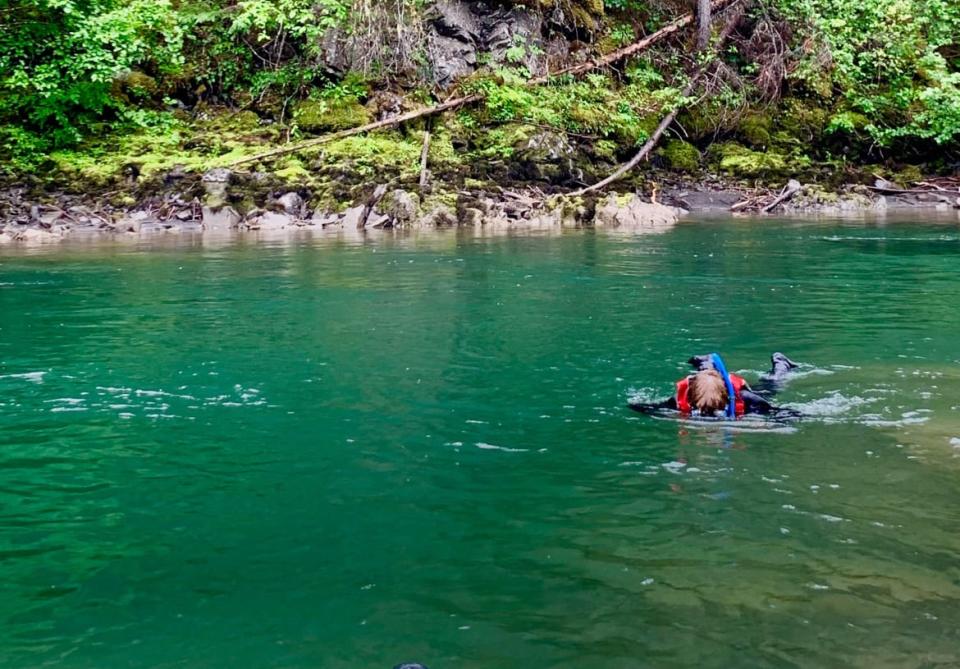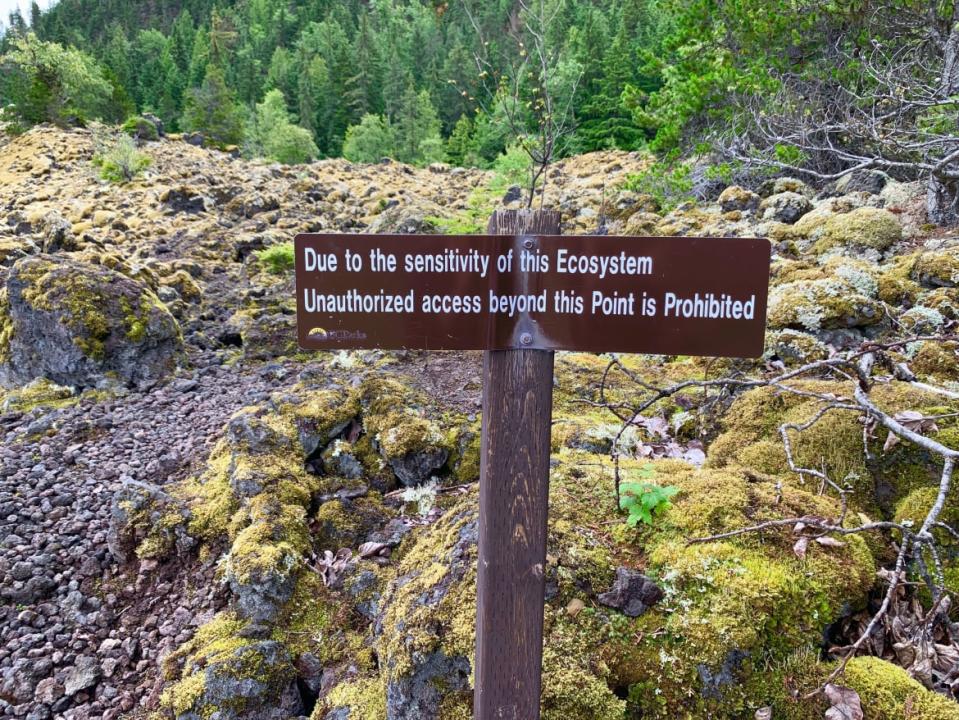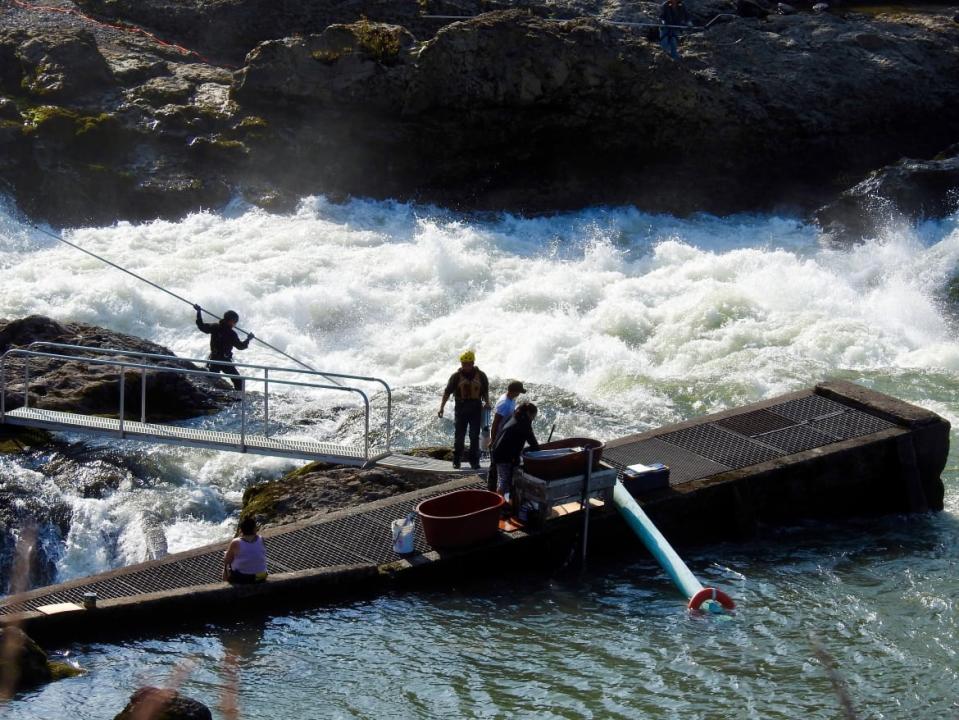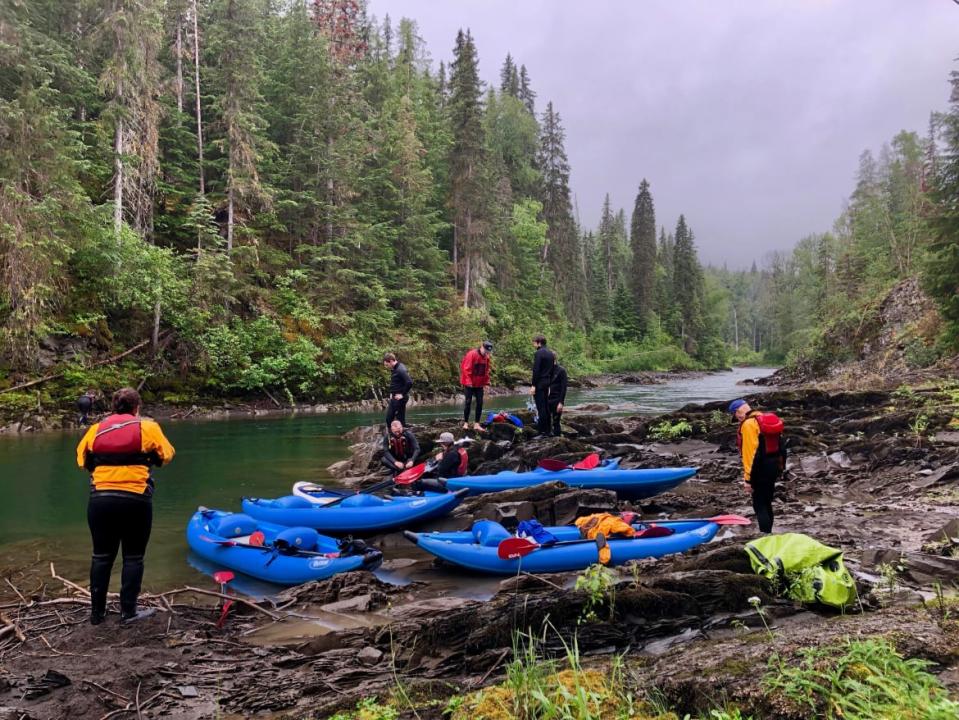Snorkeling with Salmon is Your Next Underwater Adventure

Desperate to swim with a spawning salmon, I fling myself into the Kispiox River even though the fish are late and haven’t been seen yet this year. They don’t call this murky, winding waterway the “hiding place” for nothing. Before I can search the shockingly cold water for fish, I call out for a lifejacket to go with my ill-fitting wetsuit, foggy mask and wobbly snorkel.
My body remembers swimming with salmon once before in much warmer water on the other side of the country. The way you are supposed to wear a lifejacket and float like a starfish, letting the current carry you while you fight the urge to propel yourself with disruptive breast strokes and vigorous kicks. The way that being motionless frees you to stare deeply into the depths. How, if you are lucky enough to swim over or alongside a salmon, you should look but not touch.
I know what I’m doing, but I can’t make the fish appear.
Clyde Williams would shake his head and grimace if he could see me now. We hopped in the back of his Ford F-150 yesterday and drove around the Gitsegukla First Nation, learning about totem poles and how he cleans, smokes, and dries salmon behind his house.
“Have you ever swum with salmon?” I asked, chewing on his dried fish and trying to come up with some unusual salmon small-talk to see what wisdom he might pass on.
“Noooo.” Williams shut me down with one word, so I didn’t tell him about snorkeling with salmon with researchers in New Brunswick a few years ago, writing a book about fishing experiences, or coming to northern British Columbia just to stay at Bear Claw Lodge and kayak to a spot where I can, hopefully, snorkel with salmon.

I stay in the unseasonably frigid Kispiox River longer than everyone else, longing for the sensation of being enveloped in a school of fish making their way home to spawn in the gravelly river bottom and then die. The others clearly prefer being on—not in—the Kispiox, kayaking the drizzly day away while waiting to see if the fog will lift so we can go heli-horseback riding and heli-hiking on a nearby mountain. I’ve never heli-anythinged, but salmon migrations trump helicopters in my world.
We are 800 miles north of Vancouver in the part of British Columbia that’s closer to Alaska than Alberta and that’s rich in five kinds of salmon—chinook, sockeye, coho, chum and pink—plus steelhead trout. The chinooks should have been here by now. Their absence could be blamed on climate change, overfishing, unpopular government regulations for commercial and recreational fishers, natural four-year life cycles, the weather, all of the above, or none of the above.
Salmon is part of most conversations up here. It has always been a staple food for many of the 203 Indigenous communities in this province, and anglers pay big bucks to come to wilderness lodges every fall for its cousin, steelhead trout, “the silver ghosts.” Canada’s Department of Fisheries and Oceans keeps tabs on the numbers of returning salmon and restricts the fishery whenever those numbers are low. To help protect the salmon, Bear Claw Lodge lets people swim/snorkel with them but not fish for them, and it will take guests fly fishing for steelheads, strictly catch-and-release.
My summer salmon journey begins in Smithers, an alpine-themed mountain town of 5,400 “Smithereens” and one superlative lasagna at Telly’s Grill plus the oddball “Alpenman,” an iconic wooden statue of a man dubbed Alpine Al blowing an alpenhorn. At Smithers Brewing Co., co-owner Blaine Estby did everything possible to not play up the clichéd fish angle, but after going in endless circles trying to design a logo, the brewery chose a stylized “Smithers salmon with a wheat belly.”

Driving north from Smithers, we pit-stop along the Bulkley River at Witset (Moricetown) where members of the Wet’suwet’en Nation practice a traditional Indigenous way of fishing. One man, tethered to shore with a long rope, wearing street clothes and not a protective wetsuit, uses a long dip net to scoop fish from the treacherous Widzin Kwah Canyon. It’s as beautiful and dangerous a dance with nature as I’ve ever seen, and infinitely more graceful than my awkward slithering in shallow pools along the Kispiox in search of these same fish.
Kaleigh Allen, part of the family that runs Bear Claw Lodge, guides my kayaking/attempted snorkelling with salmon outing. From her elevated perch atop a paddle board with her Karelian bear dog Willy, she suddenly spots telltale flashes of red in two pools along the way and calls out “chinooks.” The first one instantly vanishes in the murky water, but I dive in after the second one, a big, blotchy red, pink and white creature that is “not dead yet but on his way out” after spawning.
“If you’re not a fish person and you get in a big pool with fish decaying all around you, you won’t like it,” Allen quietly confides. I am a fish person and so swimming with salmon, even at the end of their incredible river-to-ocean-and-back lifecycle, is weirdly appealing.
But it’s not meant to be. I climb out of the Kispiox defeated, relieved to have survived this cold-water foolishness and concerned that the chinooks might be in trouble. (They do eventually arrive, just later and in smaller numbers than usual, while the sockeyes and pinks run on schedule.)

Salmon appear almost everywhere else that I go while in the north, though.
At the ’Ksan Historical Village, a living museum of the Gitxsan people, interpreter Samantha Johnson shows homemade wooden traps traditionally used to catch salmon and shares how fish eggs (roe) are eaten with seaweed, while the flesh is hung in the smokehouse to be preserved for winter. One lovely saying about resilience and adaptation is popular with her community: “We are a new people. We are an old people. We are the same people, deeper than before.”
I also spent several carefree hours cruising down the Skeena River with Northern BC Jet Boat Tours, watching Indigenous fishers along the way and finding grizzly prints in the sand where we stop for a shore lunch with owner Rob Bryce and Fred Seiler. The river draws its name from the Gitxsan word “ksan” for “river of the mists.” Bryce has forged ties with Indigenous communities and so we are welcomed ashore at Gitsegukla, part of the Gitxsan Nation, by Clyde Williams and two hereditary chiefs, Roddy Johnson and Vernon Milton.
The men recite a traditional greeting and then sing and drum. As we meander around the Gitxsan village of 400 people in Williams’ truck, I comment on how nobody else is out and about. Williams, a tree faller who works in the logging industry, shrugs: “It’s always quiet. People are home. Some are doing nothing. Some are eating and breathing and just living the rez life. A lot are working.” Reserves are private property in Canada and not always welcoming to strangers, so I am grateful for the chance to pepper the amiable Williams with questions about modern Indigenous life.

As an Indigenous person, he has special fishing rights and can use nets to catch salmon in the Skeena River. He has left a couple of chinook and sockeyes in a pink plastic water tank overnight so their flesh will become extra tender and juicy. Williams pulls a “jack spring” (small chinook) from the tank and deftly cleans it, dumping the guts in a bucket that will soon be returned to the river.
“This will be perfect for supper,” he says of the fish. “Filet. Wrap in foil. Barbecue.” Johnson, who is quietly watching, is gifted with fish heads for soup. Williams likes to add fish eggs to his soup, something his twin sons — who are grown and now live off-reservation — have dubbed Fear Factor Soup after the American game show.
The smokehouse is a no-frills wooden shack where Williams burns cottonwood, no bark, very dry and light. Thin salmon strips hang from wooden poles over a shouldering fire and pile of ash. The salmon that I sample has been smoked for a couple of days and is chewy, plain and pure. “Today’s generation,” explains Williams, “they’ve got candied fish strips. They’ve got all kinds of crazy ingredients. We’re one of the few that only have it this way. We haven’t done it any other way — yet. I don’t know if we’re going to go any other way with it.”

“How do you get the bones out?” he is asked. “Filet it before or they’re in there?”
“Don’t worry about it. Chew it up. You’re never going to choke on the bones. I haven’t choked on bones yet.”
Inside the smokehouse are thinner salmon strips that will hang for two or three weeks. “Look at that,” exclaims Williams, pointing to a gnawed strip. “Something’s got a hold of it. A squirrel. He found it, the little scoundrel.” I am not squeamish but wonder whether it is wise to chew where squirrels have chewed. The strips will go into the freezer so Williams can pull them out and pair them with a bag of plain potato chips for “fish and chips.” I long to taste this clever blending of old and new.
So I didn’t successfully swim with a school of spawning salmon in northern British Columbia, but I swam in the vicinity of at least one dying fish and got to eat dried salmon with Williams. I didn’t take a helicopter to the top of a mountain to ride a horse, but I rode through the Enchanted Forest where the Leonardo DiCaprio’s The Revenant was almost filmed among old-growth hemlocks and cedars, and I fell in love with what they call “holey rocks”—rocks with dramatic, weathered holes. I didn’t see a Kermode Spirit Bear, although the rare subspecies of the American black bear with a recessive gene lives up here and we dipped into the edge of the Great Bear Rainforest, but I saw a taxidermied Kermode in the Terrace airport and admired some of the white bear statues around town.
My journey starts with salmon and ends, strangely, with lava.
Before driving through the Nisga’a Nation, we stop to meet Bertram Mercer, economic development manager for the Nisga’a Lisims Government. We talk of salmon, commercial smokehouses, elusive Kermodes and a little-known volcanic eruption from nearly 300 years ago. The mid-1700s natural disaster spewed out a river of molten rock that drowned two villages and killed 2,000 people.
Now this area is called Nisga’a Memorial Lava Bed Park and is jointly managed and protected by the first nation and the provincial government. Exploring some of its 15 surreal square miles, I take a quiet walk down Crater Creek Trail, a petrified sea of lava rocks blanketed in white and green lichen. The lava beds are an unfathomable 98-feet deep in spots.
“Wil Ksi Baxhl Mihl (“Where the Fire Ran Out”) is sacred ground,” an interpretive sign explains in English and the Nisga’a language. “Please respect this ground. Tread lightly and leave the lava rocks where they are, for they are the headstones of our forefathers.” Like rivers that hold spawning salmon, this ecosystem is fragile and so I try not to disrupt it, torn between protecting it by staying silent and sharing its powerful, untold story.
Get our top stories in your inbox every day. Sign up now!
Daily Beast Membership: Beast Inside goes deeper on the stories that matter to you. Learn more.

